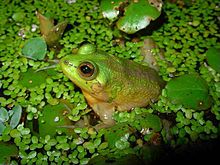| Pseudis paradoxa | |
|---|---|

| |

| |
| Two colour variants: | |
| Scientific classification | |
| Domain: | Eukaryota |
| Kingdom: | Animalia |
| Phylum: | Chordata |
| Class: | Amphibia |
| Order: | Anura |
| Family: | Hylidae |
| Genus: | Pseudis |
| Species: | P. paradoxa
|
| Binomial name | |
| Pseudis paradoxa | |
Pseudis paradoxa, known as the paradoxical frog or shrinking frog, is a species of hylid frog from South America.[2] Its name refers to the very large—up to 27 cm (11 in) long—tadpole (the world's longest), which in turn "shrinks" during metamorphosis into an ordinary-sized frog, only about a quarter or third of its former length. Although the recordholder was a tadpole in Amapá that belonged to this species, others in the genus Pseudis also have large tadpoles and ordinary-sized adults.[3][4][5]
- ^ Ariadne Angulo, Diego Baldo (2010). "Pseudis paradoxa". IUCN Red List of Threatened Species. 2010: e.T55904A11385563. doi:10.2305/IUCN.UK.2010-2.RLTS.T55904A11385563.en.
- ^ Frost, Darrel R. (2013). "Pseudis paradoxa (Linnaeus, 1758)". Amphibian Species of the World 5.6, an Online Reference. American Museum of Natural History. Retrieved 24 October 2013.
- ^ Emerson, S. B. (1988). "The giant tadpole of Pseudis paradoxa". Biological Journal of the Linnean Society. 34 (2): 93–104. doi:10.1111/j.1095-8312.1988.tb01951.x.
- ^ Garda, A. A.; D.J. Santana; V.d. Avelar São Pedro (2010). "Taxonomic characterization of Paradoxical frogs (Anura, Hylidae, Pseudae): geographic distribution, external morphology, and morphometry". Zootaxa. 2666: 1–28. doi:10.11646/zootaxa.2666.1.1.
- ^ Bokermann, W.C.A. (1967). "Girinos de anfíbios brasileiros—3: sôbre um girino gigante de Pseudis paradoxa (Amphibia, Pseudidae)". Revista Brasileira de Biologia. 27: 209–212.
